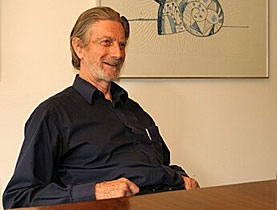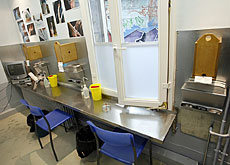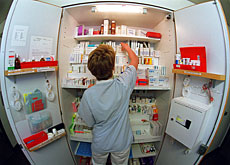A life devoted to helping drug addicts

Addiction expert Ambros Uchtenhagen helped shape Switzerland's pragmatic drugs policy after its notorious open drug scene spiralled out of control in the 1980s.
This four-pillar approach, which includes heroin substitution – a treatment he pioneered – was at first controversial. But Uchtenhagen tells swissinfo that the critics have been proved wrong.
Voters will decide on November 30 whether this drugs policy should be part of Swiss law.
In the 1980s pictures of Zurich’s open drugs scenes at “Needle Park” and Letten went round the world.
Uchtenhagen was one of the few who realised early on that an entirely different approach from just repression was needed. Championed in the cities, this policy helped form the national four-pillar drugs strategy of prevention, therapy, harm reduction and law enforcement.
The emeritus professor of social psychiatry in Zurich turned 80 this year, but his expertise is still much in demand.
He is president of the Addiction and Public Health Research Foundation in Zurich and a World Health Organization (WHO) expert. He supports the government proposal to enshrine the four pillars in law.
swissinfo: The 1960s marked the start of the permissive society. How did Switzerland deal with illegal drugs at that time?
Ambros Uchtenhagen: Drugs were a new phenomenon. As usual when you have something new and unpleasant you try to repress it and only when you realise that it cannot be repressed you think about other ways. It was also linked to youth unrest and to LSD and cannabis use.
We had to think of approaches like new types of services attractive to young people. So in the early 1970s we built up specialised low threshold drop-in centres where you could get some advice and help anonymously.
swissinfo: But by the 1980s drug use had become a real problem.
A.U.: In the beginning drug problems mainly affected those who rebelled against adult advice, like students but also young people with early delinquent activities.
This changed in the 1970s where we saw an increasing number of young people from broken homes and of poor education engaged in drug consumption. At the end of the 1980s we had a highly problematic group of users who gathered in open drug scenes of which Needle Park was the most visible.
People came in the thousands, also from other countries. Also attracted were young people with psychiatric problems drawn by Needle Park’s perceived romantic image.
But conditions soon deteriorated with a lot of violence between trafficking groups and police activities. There was a lot of misery, crime and prostitution of young girls who needed to make money for their drug consumption. The city authorities reacted very strongly but initially received little support from cantonal and national governments. It took a while for the federal government to come forward with its famous four-pillar drug policy in 1991.
swissinfo: How did the Zurich authorities go about changing their policy after Needle Park?
A.U.: We had two main phases: one was closing Needle Park. As a result drug users were dispersed over the whole city, in residential areas, in the backyards of schools.
When drug users came together again at the old Letten railway station they were allowed to stay because it was better than having them all over the city. But the situation became even more intolerable than before. We had television teams from all over the world just looking at what was going on in “clean and efficient” Switzerland.
We had to prepare another set of measures before closing down Letten, such as heroin substitution treatment, sheltered accommodation, as well as zero tolerance for public drug use and trafficking.
This policy helped to avoid the consequences of the closing down of Needle Park. When it came to closing down Letten in 1995 there were no drug users anymore, only television teams and police. Due to the success of this second phase we were able to keep up these measures.
swissinfo: So basically the new scheme involved a total change in thinking?
A.U.: The thinking was very pragmatic, taking a look at measures which answered the basic needs of drug victims and serving their needs to avoid them returning to open drug scenes.
We also looked at the needs of those who are not yet ready to give up their drugs career. Harm reduction is aimed at reducing the negative consequences of continued drug consumption in terms of health, delinquency, social disruption and so on.
swissinfo: This strategy has proven to be a great success…
A.U.: We have been able to document this. The number of overdose deaths dropped by more than 50 per cent. There has been a highly significant reduction in HIV cases among drug injectors, a significant reduction in drug-related crime in cities and – which may be even more important – an absolutely dramatic reduction in new heroin injectors.
We had seen a consistent increase in heroin addiction until 1991-2 and then a dramatic decrease of less than an eighth of what we had before. Heroin users are nowadays seen as losers and this is not very attractive. Instead we have new drug problems of cocaine and ecstasy use as well as binge drinking.
swissinfo: The Swiss pragmatic approach has had its critics.
A.U.: It attracted lot of critical comments at the beginning, also from neighbouring countries. But none of these negative consequences – described as a Damocles’ sword hanging over our country – materialised.
We haven’t seen an increase in heroin use, an undue prolongation of heroin addiction in people using substitute treatment or major tourism of drug addicts to Switzerland. All this could be very well demonstrated. So it’s no surprise that France, Germany, Austria and the European commission have introduced a fourth pillar of harm reduction as a part of their new drug policies.
swissinfo-interview: Isobel Leybold-Johnson in Zurich
The four-pillar model has been supported by the Swiss government since 1991. This, says Uchtenhagen, took some lobbying by local authorities and a coalition of three main political parties. Also key was the support of law enforcement and parents’ associations, as well as the rise in HIV/Aids among addicts.
Apart from deciding whether to enshrine the four pillars into law, so as to give it greater weight, voters will also decide on November 30 whether to support an initiative to decriminalise cannabis consumption.
While only a minority of the population uses drugs, the consumption of cocaine and, particularly among young people, the consumption of cannabis is on the rise, according to the Federal Health Office.
Uchtenhagen studied both medicine and philosophy at Zurich University, qualifying as a psychiatrist and psychotherapist.
He says his interest in addiction stems from the fact that nobody seemed to care about the topic in the 1960s. He also realised that Switzerland lagged behind.
Uchtenhagen helped built up drop in centres for addicts in the 1970s. He was also instrumental in developing the heroin substitution treatment system, in which illegal heroin is replaced by a medically prescribed opioid. This is safer for the addict and is a major part of harm reduction.
The emeritus professor of social psychiatry (1995) is nationally and internationally renowned. In late October he attended a seminar in Iran. He has also been helping Ukraine and China develop their drug policies.
A symposium of international drugs experts was held in honour of his 80th birthday earlier this year.

In compliance with the JTI standards
More: SWI swissinfo.ch certified by the Journalism Trust Initiative




You can find an overview of ongoing debates with our journalists here. Please join us!
If you want to start a conversation about a topic raised in this article or want to report factual errors, email us at english@swissinfo.ch.